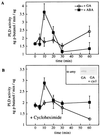Abscisic acid signal transduction in the barley aleurone is mediated by phospholipase D activity
- PMID: 9482950
- PMCID: PMC19466
- DOI: 10.1073/pnas.95.5.2697
Abscisic acid signal transduction in the barley aleurone is mediated by phospholipase D activity
Abstract
The plant hormones abscisic acid (ABA) and gibberellic acid (GA) are important regulators of the dormancy and germination of seeds. In cereals, GA enhances the synthesis and secretion of enzymes (principally alpha-amylases) in the aleurone cells of the endosperm, which then mobilize the storage reserves that fuel germination. ABA inhibits this enhanced secretory activity and delays germination. Despite the central role of ABA in regulating germination, the signal transduction events leading to altered gene expression and cellular activity are essentially unknown. We report that the application of ABA to aleurone protoplasts increased the activity of the enzyme phospholipase D (PLD) 10 min after treatment. The product of PLD activity, phosphatidic acid (PPA), also increased transiently at this time. The application of PPA to aleurone protoplasts led to an ABA-like inhibition of alpha-amylase production, and induction of the ABA up-regulated proteins ASI (amylase subtilisin inhibitor) and RAB (responsive to ABA). Inhibition of PLD activity by 0.1% 1-butanol during the initial 20 min of ABA treatment resulted in inhibition of ABA-regulated processes. This inhibition coincided with the timing of PLD activation by ABA and was overcome by simultaneous addition of PPA. These results suggest that ABA activates the enzyme PLD to produce PPA that is involved in triggering the subsequent ABA responses of the aleurone cell.
Figures






Similar articles
-
Diacylglycerol pyrophosphate inhibits the alpha-amylase secretion stimulated by gibberellic acid in barley aleurone.Physiol Plant. 2008 Nov;134(3):381-93. doi: 10.1111/j.1399-3054.2008.01148.x. Epub 2008 Jun 19. Physiol Plant. 2008. PMID: 18573189
-
Differences in phosphatidic acid signalling and metabolism between ABA and GA treatments of barley aleurone cells.Plant Physiol Biochem. 2013 Apr;65:1-8. doi: 10.1016/j.plaphy.2013.01.005. Epub 2013 Feb 4. Plant Physiol Biochem. 2013. PMID: 23416490
-
Abscisic acid stimulation of phospholipase D in the barley aleurone is G-protein-mediated and localized to the plasma membrane.Plant Physiol. 2000 Oct;124(2):693-702. doi: 10.1104/pp.124.2.693. Plant Physiol. 2000. PMID: 11027718 Free PMC article.
-
Proteomes of the barley aleurone layer: A model system for plant signalling and protein secretion.Proteomics. 2011 May;11(9):1595-605. doi: 10.1002/pmic.201000656. Epub 2011 Mar 23. Proteomics. 2011. PMID: 21433287 Review.
-
Programmed cell death in cereal aleurone.Plant Mol Biol. 2000 Oct;44(3):255-66. doi: 10.1023/a:1026584207243. Plant Mol Biol. 2000. PMID: 11199387 Review.
Cited by
-
Trivalent ions activate abscisic acid-inducible promoters through an ABI1-dependent pathway in rice protoplasts.Plant Physiol. 2000 Aug;123(4):1553-60. doi: 10.1104/pp.123.4.1553. Plant Physiol. 2000. PMID: 10938371 Free PMC article.
-
Purification and identification of a 42-kilodalton abscisic acid-specific-binding protein from epidermis of broad bean leaves.Plant Physiol. 2002 Feb;128(2):714-25. doi: 10.1104/pp.010531. Plant Physiol. 2002. PMID: 11842174 Free PMC article.
-
Wheat transcriptome profiling reveals abscisic and gibberellic acid treatments regulate early-stage phytohormone defense signaling, cell wall fortification, and metabolic switches following Fusarium graminearum-challenge.BMC Genomics. 2021 Nov 6;22(1):798. doi: 10.1186/s12864-021-08069-0. BMC Genomics. 2021. PMID: 34742254 Free PMC article.
-
Phospholipase D activation is required for 1-aminocyclopropane 1-carboxylic acid signaling during sexual reproduction in the marine red alga Neopyropia yezoensis (Rhodophyta).BMC Plant Biol. 2022 Apr 8;22(1):181. doi: 10.1186/s12870-022-03575-z. BMC Plant Biol. 2022. PMID: 35395727 Free PMC article.
-
The sensitivity of barley aleurone tissue to gibberellin is heterogeneous and may Be spatially determined.Plant Physiol. 1999 Jun;120(2):361-70. doi: 10.1104/pp.120.2.361. Plant Physiol. 1999. PMID: 10364387 Free PMC article.
References
-
- Hong B, Barg B, Ho T-h D. Plant Mol Biol. 1992;18:663–674. - PubMed
-
- Heimovaara-Dijkstra S, Vanduijn B, Libbenga K R, Heidekamp F, Wang M. Plant Cell Physiol. 1994b;35:743–750.
Publication types
MeSH terms
Substances
LinkOut - more resources
Full Text Sources

